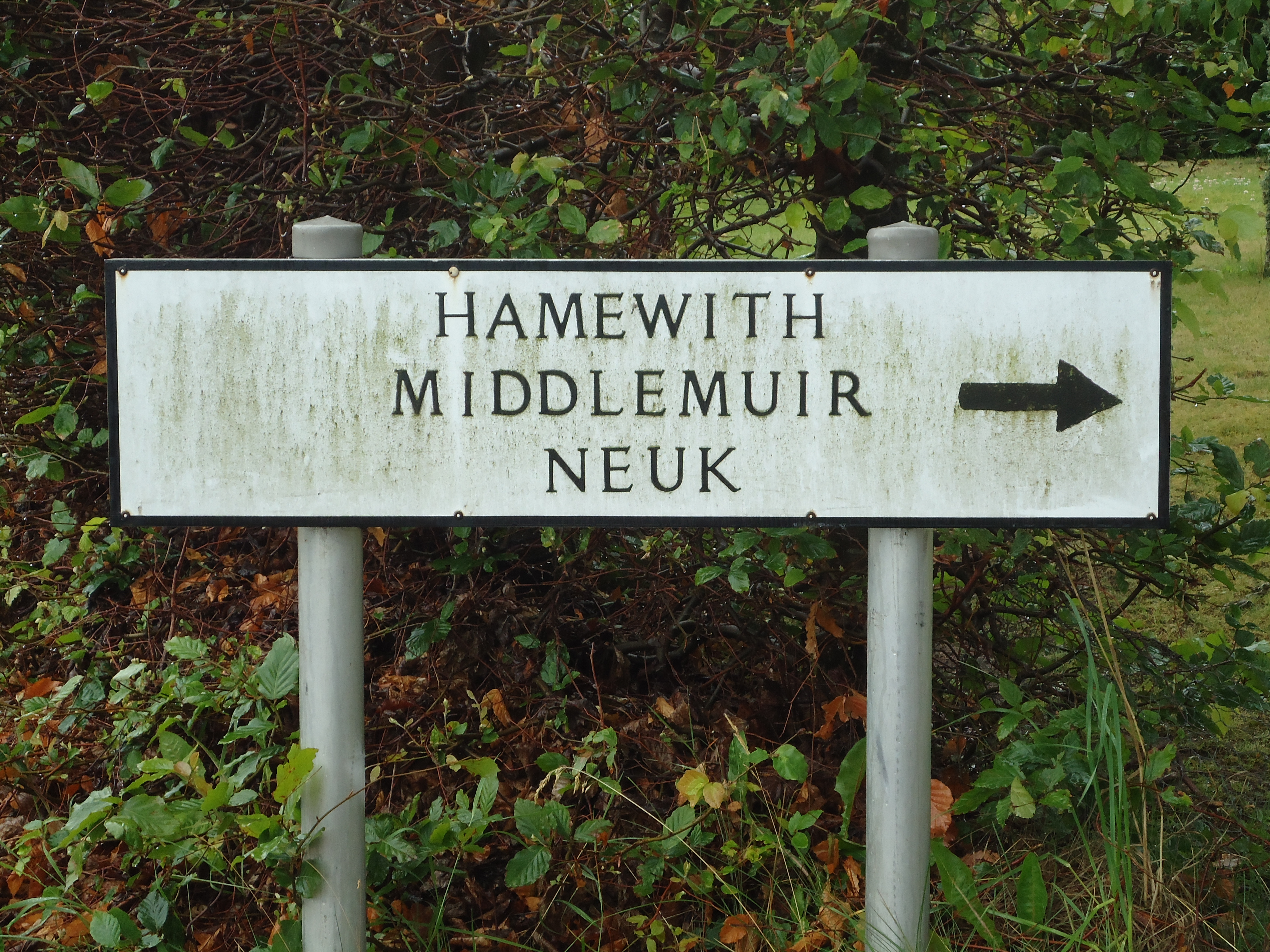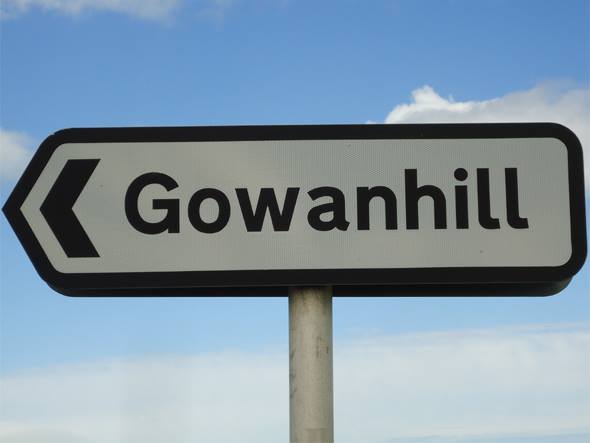Wir Ain Leed — Mid Northern Scots
This dialect is also referred to as 'North East Scots', 'the Doric' or 'the Moray Claik' and 'the Buchan Claik'. The name Doric comes from the Greek for 'rural' or 'rustic'. The term was originally used to describe Scots in general but now just tends to refer to the Mid Northern Scots dialect.
Consonants
In Mid Northern Scots consonants, except those below, generally have the same phonetic values (pronunciation) as in Standard English. For more detail see Orthography.
Initial <f> is often /fj/ in words like fact, fauch and ferm etc.
Initial <g> is often /gj/ in words like gang and gie etc. In Buchan that may be /dj/.
Before <nt>, <a> and <e> may be /ɪ/ in words like want, kent, pent and enter.
In Moray and Upper Banff <r> may be elided before /s/ in words such as first, hairst, hirsle, hirst, horse and purse.
On the Moray Firth coast <v> may be pronounced /w/ in words such as nervish, raivel, vailyie, veesion, veesit and verra.
Medial and final <ch> in words such as bocht, loch and nicht is usually /x/ but the cluster <cht> is sometimes pronounced /θ/ in words Such as dochter, micht and nocht etc.
initial <ch> is usually /ʧ/ in words such as chap, chield, chirl and initial chowk.
The cluster <nch> is usually /nʃ/ in words such as brainch, clinch, dunch, hainch, inch and French.
The cluster <tch> is usually /ʧ/ in words such as fleetch and wratch.
The trigraph <dge> is usually /ʤ/ in words such as begrudge, cadge, cruldge and fadge. However, the graphemes <g> and <ge> are occasionally /ʤ/ in words such as breinge and gigot.
Initial <gn> is usually /gn/ in words such as gnap, gnaw.
Initial <kn> is usually /kn/ in words such as knap, knee, knot and knowe.
 Turriff, Aberdeenshire
Turriff, AberdeenshireMedial and final <ld> is usually simplified to /l/ in words such as auld, bield, cauld, elder and fauld. Reversal of /d/ and /l/ may occur in words like warld [wardl] and field [fidl] etc.
Medial and final <nd> is usually simplified to /n/ in words such as baund, daunder, haund, find and sindry.
The digraph <ng> is usually /ŋ/ in words such as finger, hing, ingan and single.
The digraph <nk> is usually /ŋk/ in words such as bink and hank.
The digraph <qu> is usually /kw/ in words such as acquent, quair and queen
The digraph <sh> is usually /ʃ/ in words such as creash and sheep. However, it may occasionally be /ʒ/ in words such as fushion and pushion.
The digraph <th> is usually /θ/ in words such as graith, thole and thrawn and /ð/ in words such as blether, thaim, thair, in Buchan, medially before <er> that is often /d/.
 Formartine, Aberdeenshire
Formartine, AberdeenshireThe digraph <wh> is usually /f/ in words such as wha, whan and wheech, however, /ʍ/ may occur in some words, for example, wheel.
Initial <wr> is often /vr/ in words such as wrack, wrang, wricht and write.
Vowels and Diphthongs
Vowels in unstressed positions are usually /ə/ in words such as aboot, the, oxter, duntit, bannock and smeddum.
Initial <a> is /ə/ in ahint, and awa etc. otherwise <a> is usually /a/ in words such as aff, lang, mak, wash and watch. However, final <a> is /aː/ in words such as awa, twa and wha.
 Auldmeldrum, Aberdeenshire
Auldmeldrum, AberdeenshireInitial and medial <au> is usually /aː/, however, in Buchan fishing villages /ɔ/ before <m>, <n> and <ng> may occur, in words such as auld, haud, haund, saul, saund and slauchter.
 Aberchirder, Aberdeenshire
Aberchirder, AberdeenshireFinal <aw> is usually /aː/ in words such as aw, blaw, caw, draw, faw, gaw, gnaw, haw, slaw, snaw and staw. However, in Buchan, in words without Standard English cognates in <-al(l)>, final <w> may be /v/, often having /j/ before the preceding vowel, giving awe [jaːv], blaw [bl(j)aːv], gnaw [gnjaːv], law [ljaːv], snaw [snjaːv] and taw [tjaːv, tʃaːv] etc.
Occasionally <aw> is /aː/ in words such as awn, awfu, bawbee and bawsant.
Initial and medial <ai> is usually /e/ in words such as aiblins, aik, aiple, ait, aith, braid, craitur, fain, gaither, graith and haimer. In some areas /əi/ occurs, usually after /w/ and a dark /l/ and sometimes after other consonants in words such as waik and wait. After /k/ and /n/, /ja/ may occur, in for example, caird, naig and naitur.
 Aberdeen
AberdeenThe cluster <a-e> is usually /e/ in words such as ale, face, gate, hame and Pace. In some areas /əi/ occurs, usually after /w/ and a dark /l/, and sometimes after other consonants in words such as plate, wade, wale, wame. Sometimes after /k/, /ja/ may occur, in for example, cake and nakit.
The cluster <ane> is usually /i/, however, Moray and Nairn usually have /e/, in words such as alane, ane, ance, bane, gane, mane, nane and stane.
Final <ae> is usually /e/ in words such as ae, brae, f(r)ae, gae, sae, tae n. and wae, however, it is /i/ in adae, dae, shae, tae v.
Final <ay> is usually /e/ in words such as day, gray and lay.
The digraph <ea> is usually /i/, in Coastal dialects, Moray and Nairn it is usually always /e/, in words such as beast, cheap, deave, east, heap, hear, meat, ream, sea and tea. However, before /v/ and /z/ it may be /əi/ or /ɪ/ in, for example, reason and season. Before /k/ it may be /ɪ/ in, for example, speak. In some areas /əi/ occurs, usually after /w/ and a dark /l/ and sometimes after other consonants in words such as great, quean, speak, squeal and weave.
The digraph <ee> is usually /i/ in words such as dee, dree, eetem, freet, jeely, keep, meet, teeth, weel and weet. Before /k/ it may be /ɪ/ in, for example, week. In some areas /əi/ may occur, usually after /w/ and a dark /l/ and sometimes after other consonants, in words such as heeze and swee.
The digraph <ei> is usually /i/, in some words it may be /e/, Coastal dialects, Moray and Nairn usually have /e/, in words such as beir, deid, heid, meidae, peir, spreid, teir and threid. Before /v/ and /z/ it may be /əi/ or /ɪ/ in heiven and seiven. In some areas /əi/ occurs, usually after /w/ and a dark /l/ and sometimes after other consonants, in words such as seiven and sweit. The digraph <ei> before /x/ is usually /i/ in words such as dreich, heich and skeich.
The digraph <ie> is usually /i/ in words such as bield, chield, scrieve and shielin.
The grapheme <e> is usually /ɛ/, in coastal villages /ei/ may occur, in words such as bed, ebb, esh, fecht, gled, gless, seck and wecht.
The grapheme <i> is usually /ɪ/ in words such as drink, in, inch, licht, lift, pit, rin, simmer, sin and stibble. After initial /k/ it may be /wɪ/ in kintra [ˈkwɪntrə].
After <w> and <wh>, <i> is often /ʌ/ in words such as whin, whisper, whit, wid, wind, wir, wird, wirm and wittins.
The graphemes <o> and <oa> are usually /ɔ/. However, /o/ may also occur and away from Aberdeen <o> (/ɔ/) and <oa> (/o/) may be distinguished, in words such as boat, boss, box and coal. After initial /k/ it may be /wəi/ in words such as coal [kwəil] and coat [kwəit].
 Elgin, Moray
Elgin, MorayThe digraph <oo> is usually /u/ in words such as aboot, coont, droop, hoose, moose, oot, scoor and soond.
The digraph <ou> is usually /u/ in words like allou, bouk, broun, coum, cour, doun, dout, poupit, thoum. After initial /k/ it may be /wɪ/ in coud [kwɪd].
The cluster <u-e> is usually /u/ in words such as dule and hure.
The grapheme <u> is usually /ʌ/ in words such as bund, burn, drunken, fund, grund, truff, unce and wund. After /k/ it may be /ja/ in, for example, curn.
 Orton, Moray
Orton, MorayThe digraph <ui> is usually /i/, in Moray and Nairn before /r/ it is usually /(j)uː/, in words such as abuin, abuise, bluid, bruit, buird, duin, fluir, fruit, fuird, luim, luif, muin, muir, muisic, ruise, shuir, spuin, uiss, uise and Yuil. However, after /g/ and /k/ it may be /wi/ in words such as cuil, cuit, guid and schuil.
The digraph <eu> is usually /ju/ in words such as beuch, beuk, eneuch, heuk, leuch, leuk, neuk, sheuch, teuch and teug.
The digraph <ew> is usually /jʌu/ in words such as dew, few, new and spew.
Also in words like beauty and duty.
The clusters <i-e> and <y-e> are usually /əi/, in Buchan /ɔi/ may occur, in words such as advice, bide, bile, fine, fire ile, rive, tyne, wise adj. and wyte.
The graphemes <ey> and <ye> are usually /əi/ in words such as cry, eyntment, eyster, fley and kye.
The graphemes <oi> and <oy> are usually /oi/ in words such as Boid, foy, noise and ploy.
 Fraserburgh, Aberdeenshire
Fraserburgh, AberdeenshireInitial and medial <ow> is usually /ʌu/, however, before /k/, /jo/ may occur, in words such as bowt, cowp, cowt, gowd, gowf, lowp and owsen.
Root final <owe> is also /ʌu/ in words such as flowe, glowe, growe, howe, knowe, lowe, rowe and towe.
Suffixes
Strictly speaking not a suffix, <ae> is usually /ə/, however, /e/ also occurs, in words such as Americae, arrae, barrae, nairae, swallae and windae.
The diminutive <ie> is usually /i/, however, if the preceding vowel is /i/ or /əi/, or the preceding consonant is /b, d, ð, g, v, ʒ/ or /z/, the pronunciation is /i/, otherwise /ɪ/, in words such as grannie, laddie, lassie, shappie and wifie.
Adjectival <fu> is usually /fɛ/, however, /fe/ also occurs, in words such as awfu, carefu and mensefu.
The negative particle <na> is usually /nə/ in words such as daena (dinna), haesna, maunna, winna and wisna.
Adverbial and adjectival <y, ie> is usually /i/ if the preceding vowel is /i/ or /əi/, or the preceding consonant is /b, d, ð, g, v, ʒ/ or /z/, otherwise /ɪ/ in words such as reekie, sairy, stany and stourie.
Adverbial <ly> is usually /li/ if the preceding vowel is /i/ or /əi/, or the preceding consonant is /b, d, ð, g, v, ʒ/ or /z/, otherwise /lɪ/ in words such as brawly, feckly, fully, geyly, likely and uncoly.
In phrases beginning with in the, on the, at the and o the, the two words are contracted into ee [iː] in colloquail speech.
Thae and thir are replaced by the plural use of this and that.
Initial <th> is often elided in words like this and that, especially in Buchan.
The preposition 'gin is also used to mean 'by the time that' - 'Gin we get thare it'll be daurk!
A wealth of material in the distinctive Scots of the North-East at The Elphinstone Kist.
Aiming to create and support a sustainable, dynamic future for Doric as a vibrant language: The Doric Board.
Literature:
Dieth, Eugen (1932) A Grammar of the Buchan Dialect, Cambridge University Press.
Wölck, Wolfgang (1965) Phonematische Analyse der Sprache von Buchan, Heidelberg: Winter.
Mather, James Y. and H. H. Speitel (1986) The Linguistic Atlas of Scotland volume 3, London: Croom Helm.
Johnston, Paul (1997) "Regional variation" in Charles Jones ed. The Edinburgh History of the Scots Language, Edinburgh University Press, 443-513.
